The Goldilocks planet: why Earth is our oasis
Expert reviewers
Essentials
- We thrive on Earth because we evolved here: it’s not too hot, not too cold, and has everything we need to flourish.
- Our planet’s position and movement in space has influenced what Earth is today.
- The complex web of organic and inorganic systems on Earth have evolved together, adding further complexity to what makes our planet so comfortable.
- The future stability of our climate, ecosystem and orbit are not guaranteed.
Our planet appears to be an oasis in the vast reaches of space. Neighbouring planets offer little hospitality, and even though we’re edging closer to landing humans on Mars, living there would be extremely difficult. Earth is where we are finely tuned to live: it’s not too hot or too cold, but just right—like the porridge in the story of Goldilocks.
This is not mere coincidence. We thrive on Earth because we evolved to live here. But not every planet sits within such a ‘Goldilocks’ zone for life as we know it, and those that do aren’t guaranteed to be anything like Earth.
So what makes our planet so perfect? And will it remain our oasis forever?
Our place in space
It’s tempting to think of Earth as a closed system, safe and snug in the bubble of its atmosphere, unaffected by what happens out in space. But we’re part of a much larger environment that extends far beyond our planet.
Liquid water and distance from the sun
If a planet is too close to its sun, temperatures soar and liquid water boils into gas. Too far away, and almost everything freezes. So around each star there’s a sweet spot where planets have the potential for liquid water on their surface.
But while the distance from the sun is important, it’s not the only variable that defines our home in the solar system. For starters, the temperature of a planet is not always so easy to guess based on distance from the sun alone.
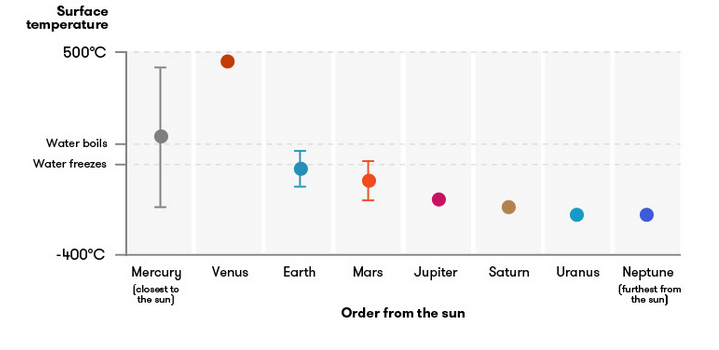
Notice how Venus is way hotter than it looks like it should be, and Mercury’s lowest temperature is even colder than that of Mars and Jupiter, despite Mercury being much closer to the sun.
Wobbly, tilting, eccentric planets
From the extremes of Mercury to the comparably mild temperatures on Earth, the possible range of a planet’s temperature is often the result of how that planet moves and is oriented in space.
A variety of orbits
Here are some of the ways climates of planets or moons can differ based on how they and their neighbours move through space.
 Less tidal force
Less tidal force
 More tidal force
More tidal force
Tidal forces are the changes in gravitational forces on an object over time, caused by other celestial bodies. In extreme cases, tidal forces can cause planets and moons to distort in shape as they orbit each other, leading to changes in heat, volcanic activity or ocean currents.
 Less tilted
Less tilted
 More tilted
More tilted
Axial tilt is the amount that a planet is angled relative to the object it orbits. On Earth, our tilt gives regions closer to the northern and southern poles four distinct seasons, and those near the equator have a tropical climate all year round.
 Less wobbly
Less wobbly
 More wobbly
More wobbly
Axial precession is the amount that planets and moons wobble around on their spin axis. Like a slow-motion spinning top, this changes the direction that the north and south poles of the planet are facing, which in turn affects the intensity of the seasons.
 Less eccentric
Less eccentric
 More eccentric
More eccentric
Orbital eccentricity is how much a planet’s orbit deviates from a perfect circle. Currently, the Earth’s orbit is almost circular. Planets with more eccentric orbits can have huge differences in temperature as they get closer to and further away from the sun.
So while it’s tempting to think that our tides, days, seasons and years are eternal, the reality is that they are the result of a grand celestial dance with many moving partners. Where we started in this dance, what we collided with, what we're near and the way we're oriented—these factors can not only change the length of our days and years, but change our climate, too. And they can, and do, change over time.
But even with these cycling changes, Earth still seems to be lucky in how it’s positioned and oriented, and moves through space. It’s not too tilted, not too eccentric, not too wobbly, and not too squished by nearby forces.
Is Earth really in a perfect spot?
When we compare our planet to other seemingly inhospitable ones, whether in regards to our distance from the sun, or our orbit, or even our climate, is it accurate to use words like ‘perfect’, ‘lucky’, or even ‘balanced’? After all, it could have been more stable. We have seasons, tides, climate cycles that include ice ages, and other challenges that are the results of how Earth, our moon and our neighbouring planets move through space.
The problem with viewing our place in space as ‘lucky’ is that we are judging it based on our requirements for living here—but our requirements for living here are the result of living here. If our planet had no tilt, for instance, life on Earth may have evolved to rely on the lack of summer and winter, and perhaps we would have viewed tilted planets as uninhabitable.
So calling our planet perfect is the result of circular thinking—but it’s circular thinking that’s difficult to avoid. We’ve never met life beyond Earth, so we don’t know exactly what the full range of possible conditions for life are.
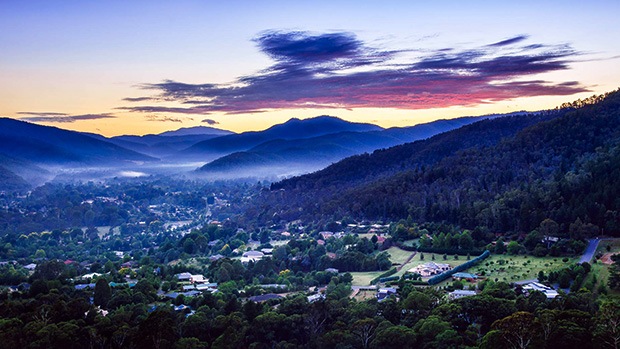
Compared to other planets, Earth may seem ‘perfect’ or ‘balanced’ … but this is a matter of perspective. Image source: Brendan Holland / Flickr.
A planet similar to Earth wouldn’t necessarily be habitable for us, because we are so closely entwined with the history of our home.
Evolving with our planet
Our planet has had many faces through its 4.5 billion year history: landscapes, weather, climate … almost nothing has remained the same for long. In addition to that, living creatures change the planet, the planet changes living creatures, and living creatures change each other. We’re all part of a big, interconnected ecosystem of living and non-living things.
Dynamic, non-living systems
We’ve already looked at the orbit of the planet, which can change over time and affect the climate. There’s also the changing geology of Earth, which has led to dramatic changes like the formation of mountains or the separating of lands. Perhaps more important to our survival, though, are the properties of our atmosphere.
The extreme heat of Venus (regularly reaching up to a melting 460°C/860°F) is caused by a runaway greenhouse effect. It has a thick atmosphere made mostly of carbon dioxide, which, as it does on Earth, traps heat from the sun. The more heat it traps, the thicker the atmosphere becomes, and the cycle goes on. Evidence suggests that Venus and Earth might once have been very similar but, due to slight differences in conditions, the atmosphere of Venus was able to reach a tipping point, initiating the runaway greenhouse effect and pushing it past the point of no return.
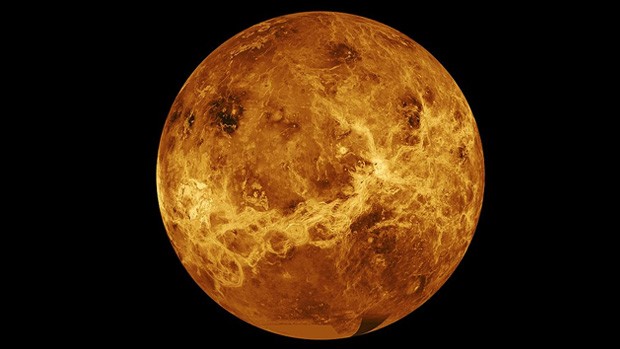
A runaway greenhouse effect led to the incredibly hot surface temperature on Venus, which reaches over 460°C. Image source: NASA / Wikimedia Commons.
A thin atmosphere is another kind of problem. Without any heat trapped at all, temperatures fluctuate to extremes between day and night. Plus, without an atmosphere to trap gases near the surface of a planet, there’s nothing to breathe. This brings us to another one of our requirements: oxygen.
Life and Earth, entwined
Up until 2.45 billion years ago, there was almost no oxygen in the atmosphere. Then, cyanobacteria GLOSSARY cyanobacteriatiny organisms that conduct photosynthesis to turn sunshine, water and carbon dioxide into carbohydrates and oxygen —the first known creatures to conduct photosynthesis—began to flourish. They released so much oxygen that it eventually became the second most common gas in our atmosphere. Ultimately, we have these tiny little creatures to thank for the oxygen we breathe today.
Could humans have developed without oxygen? We as oxygen-breathing mammals certainly wouldn’t have, but perhaps different species would have flourished in our place. The important point is that we do need oxygen, and so we do need a planet with oxygen in its atmosphere, whether or not it’s caused by something like Earth’s cyanobacteria. But this is far from being our only requirement—consider the food we eat, the clothes we wear, the medicines we use … we have a long, long list of reasons why we rely on the plants, animals and greater ecosystems of Earth.
Habitability is about the complex relationship between life and environment. So even if we found a faraway planet that’s perfectly positioned in space for us: one that’s not too close or too far from the sun; one without an extreme tilt or orbit or wobble; one with liquid water; one with a bearable atmosphere; and one that meets all the other requirements we haven’t even touched on (bearable gravity, lack of collisions, composition of the atmosphere, availability of chemicals) … we’d still need to pack our bags with plenty of plants, animals and microbes, and introduce them in such a way that would result in a stable ecosystem over long timescales. It’s a big ask. Perhaps living on another planet is possible, perhaps it’s science fiction. We still have much to learn.
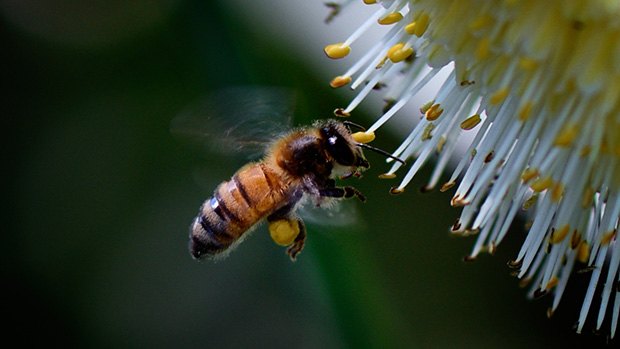
Over time, living creatures change the planet, the planet changes living creatures, and living creatures change each other. Image source: Rod Waddington / Flickr.
Earth’s stability, past and future
Earth won’t always be the oasis it is today. It hasn’t always been the same in the past, and it won’t remain this way forever. There is no true ‘equilibrium’ for our planet—only phases of more or less stability.
But we won’t remain the same, either. We and our descendants will continue to change over time, just like other living things. So will we, and our descendants, always be able to live here?
Gradual vs sudden change
Change is a normal part of any dynamic system, but one of the most important factors for our ongoing survival is the rate of change. Gradual change will always happen: mountains will slowly form, landmasses will creep away from each other or move closer together, the moon will inch away from our planet, and new species will emerge while others go extinct. As long as these changes happen at a slow enough pace, we can probably figure out how to survive, whether by using our brains or relying on the very gradual process of evolution.
Sudden change, however, is another issue—from small effects that eventually cause abrupt changes or sudden catalysts like asteroid collisions, big shifts in Earth’s history have marked points where many species fall. Today, we are living through a period of environmental stress due to anthropogenic GLOSSARY anthropogeniccaused by human activity climate change. Climate change may feel like it’s happening at a crawling pace, but it is a rapid event in the timescale of our planet, and it’s already causing the extinction of species.
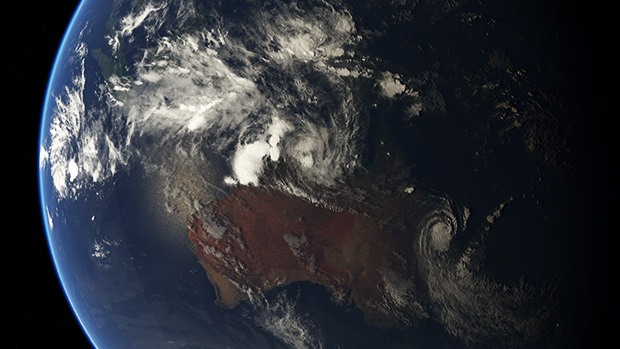
Earth is always changing, and not all species will survive. The rate of change is important—the faster the planet changes, the greater our challenges are. Image copyright: EUMETSAT 2015.
Ultimate thresholds
Even if we’re able to avoid current and future disasters for our planet, our survival is not guaranteed forever. With enough time, gradual changes can cross thresholds beyond which we can no longer survive. For Earth, a significant threshold will occur in about a billion years: when the increasing brightness of the sun warms the planet so much that it overheats like Venus.
So even though we are part of an intricate web of life, if we want our descendants—or any Earth life at all—to survive forever (if that’s even possible), we may need to eventually move to other planets and beyond. This is no easy feat, and we still need to look after our home planet into the far, foreseeable future. But if we needed to move, could we?
Could we live anywhere else?
Setting up permanent colonies on Mars or the moon is one step towards planetary independence, but if those colonies can only survive by receiving supplies from Earth, it’s not a long-term solution. Terraforming GLOSSARY Terraformingtransforming a planet or moon to be able to support Earth life—for example, by seeding it with plants, altering its atmosphere and climate, building, modifying its mountains and rivers, and so on may be able to provide the next step—but we’re still a long way off from being able to do this. Even so, it may one day become an option for turning almost-habitable planets like Mars into places that can better sustain colonies.
As for the ongoing search for exoplanets GLOSSARY exoplanetsplanets beyond our own solar system in our local neighbourhood, the discoveries of thousands of potentially habitable planets may have you excited that a new home is just around the corner. But, in reality, there’s much more we need to learn. There are doubts that some “Earth-like planets” really exist, let alone whether they’re suitable for us—not to mention that they are many light years away. And if we do find a good match, we still face the lack of Earth’s ecosystems needed for our long-term survival.
Home
So here we are, on Earth—our Goldilocks planet. Its position and movement in space makes it not too hot, and not too cold. We’ve got liquid water and a decent atmosphere, and plenty of sources of food. We still face many challenges and our planet has suffered from some wobbles and collisions, but we’ve survived it all, so far.
We’re fine tuned to live here because it’s the environment that we and our ancestors grew up in. It contains our fellow humans, and it contains our food. On Earth, we’re part of a greater ecosystem of living and non-living things. There are no guarantees that Earth will be suitable for us forever, but it’s going to be our only home far into the forseeable future—so we need to look after it.





